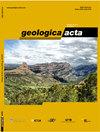成分不同的岩浆之间的共生作用(晚石炭世-早二叠世Santa Eulália Monforte地块,Ossa Morena带):场关系和地质年代限制
IF 2
4区 地球科学
Q2 GEOLOGY
引用次数: 12
摘要
Santa Eulalia Monforte地块是一个运动后的晚石炭世-早二叠世钙碱性复合地块(LC-EP),位于奥萨-莫雷纳带(OMZ,葡萄牙)。本文研究了该地块外环粉红色花岗岩和镁铁质中间岩之间的场关系,并提出了新的U-Pb锆石年龄测定方法。估计的206Pb/238U年龄,粉红色花岗岩297±4Ma,辉长岩闪长岩303±3Ma,表明两种岩浆结晶之间的时间间隔很短。在露头尺度上,镁铁质中间岩与寄主粉红色花岗岩的接触是尖锐的,并证实了这种年龄关系,但不能证明为什么寄主飞地接触通常具有弯曲和不规则的形状,表明液-液相互作用。对U-Pb锆石年龄分布和各自Th/U比率的全面分析表明,组成不同的岩浆大致是同时代的。所获得的年龄也符合LC-EP伊比利亚钙碱性岩套,该岩套与伊比利亚-Armorican弧的发展同时形成,当时古特提斯洋板块在欧亚活动边缘下俯冲。以这种地球动力学背景为参考,LC-EP伊比利亚钙碱性岩浆活动最有可能与Cimmerian旋回有关,而不是传统上公认的将这种岩浆活动与华力西旋回联系更紧密的模型。Santa Eulalia Monforte地块是一个运动后的晚石炭世-早二叠世钙碱性复合地块(LC-EP),位于奥萨-莫雷纳带(OMZ,葡萄牙)。本文研究了该地块外环粉红色花岗岩和镁铁质中间岩之间的场关系,并提出了新的U-Pb锆石年龄测定方法。估计的206Pb/238U年龄,粉红色花岗岩297±4Ma,辉长岩闪长岩303±3Ma,表明两种岩浆结晶之间的时间间隔很短。在露头尺度上,镁铁质中间岩与寄主粉红色花岗岩的接触是尖锐的,并证实了这种年龄关系,但不能证明为什么寄主飞地接触通常具有弯曲和不规则的形状,表明液-液相互作用。对U-Pb锆石年龄分布和各自Th/U比率的全面分析表明,组成不同的岩浆大致是同时代的。所获得的年龄也符合LC-EP伊比利亚钙碱性岩套,该岩套与伊比利亚-Armorican弧的发展同时形成,当时古特提斯洋板块在欧亚活动边缘下俯冲。以这种地球动力学背景为参考,LC-EP伊比利亚钙碱性岩浆活动最有可能与Cimmerian旋回有关,而不是传统上公认的将这种岩浆活动与华力西旋回联系更紧密的模型。本文章由计算机程序翻译,如有差异,请以英文原文为准。
Coeval interaction between magmas of contrasting composition (Late Carboniferous-Early Permian Santa Eulália-Monforte massif, Ossa-Morena Zone): field relationships and geochronological constraints
The Santa Eulalia-Monforte massif is a post-kinematic Late Carboniferous-Early Permian calc-alkaline composite massif (LC-EP) located in the Ossa-Morena Zone (OMZ, Portugal). This paper examines the field relationships between pinkish granites and mafic-intermediate rocks from the external ring of this massif and presents new U-Pb zircon age determinations. The estimated 206 Pb/ 238 U ages, 297±4Ma for the pinkish granite and 303±3Ma for a gabbro-diorite point to a short time interval between the crystallization of both magmas. At outcrop scale, contacts of the mafic-intermediate rocks with the host pinkish granite are sharp and corroborate this age relationship, but do not justify why the host-enclave contacts often has curved and irregular shapes, indicating liquid-liquid interaction. A full analysis of the distribution of U-Pb zircon ages and respective Th/U ratios suggests that the compositionally distinct magmas were roughly contemporaneous. The obtained ages also fit the LC-EP Iberian calc-alkaline suite that was formed contemporaneously to the development of the Iberian-Armorican Arc and when the Paleotethyan oceanic Plate subducted under the Eurasian active margin. Taking this geodynamic setting as a reference, the LC-EP Iberian calc-alkaline magmatism can be interpreted as most probably related to the Cimmerian cycle instead of the traditionally accepted model that ascribe a closer connection of this magmatism with the Variscan cycle. The Santa Eulalia-Monforte massif is a post-kinematic Late Carboniferous-Early Permian calc-alkaline composite massif (LC-EP) located in the Ossa-Morena Zone (OMZ, Portugal). This paper examines the field relationships between pinkish granites and mafic-intermediate rocks from the external ring of this massif and presents new U-Pb zircon age determinations. The estimated 206 Pb/ 238 U ages, 297±4Ma for the pinkish granite and 303±3Ma for a gabbro-diorite point to a short time interval between the crystallization of both magmas. At outcrop scale, contacts of the mafic-intermediate rocks with the host pinkish granite are sharp and corroborate this age relationship, but do not justify why the host-enclave contacts often has curved and irregular shapes, indicating liquid-liquid interaction. A full analysis of the distribution of U-Pb zircon ages and respective Th/U ratios suggests that the compositionally distinct magmas were roughly contemporaneous. The obtained ages also fit the LC-EP Iberian calc-alkaline suite that was formed contemporaneously to the development of the Iberian-Armorican Arc and when the Paleotethyan oceanic Plate subducted under the Eurasian active margin. Taking this geodynamic setting as a reference, the LC-EP Iberian calc-alkaline magmatism can be interpreted as most probably related to the Cimmerian cycle instead of the traditionally accepted model that ascribe a closer connection of this magmatism with the Variscan cycle.
求助全文
通过发布文献求助,成功后即可免费获取论文全文。
去求助
来源期刊

Geologica Acta
地学-地质学
CiteScore
2.50
自引率
6.70%
发文量
13
审稿时长
>12 weeks
期刊介绍:
- Relevant conceptual developments in any area of the Earth Sciences.
- Studies presenting regional synthesis.
- Thematic issues or monographic volumes presenting the results from one or more research groups.
- Short papers reflecting interesting results or works in progress.
- Contributions and results from Research Projects, Workshops, Symposiums, Congresses and any relevant scientific activity related to Earth Sciences.
- Geologica Acta aims to stimulate rapid diffusion of results and efficient exchange of ideas between the widespread communities of Earth Science researchers (with special emphasis on Latinamerica, the Caribbean, Europe, the Mediterranean
 求助内容:
求助内容: 应助结果提醒方式:
应助结果提醒方式:


